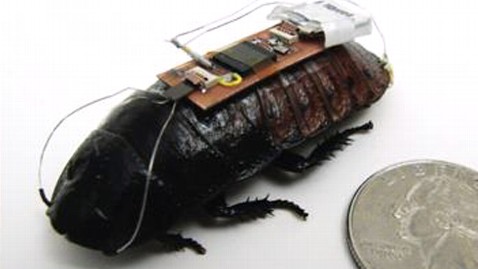Earthquake First Responders: Cockroaches

(Image Credit: iBionicS)
Move over search-and-rescue dogs. First-responding cockroaches might be the next big thing in disaster response.
Researchers at North Carolina State University in Raleigh hope the unsightly pests can be put to good use, saving lives in disasters like earthquakes, fires and chemical attacks.
"Our research is basically to turn insects into beasts of burden as we did with larger animals: horses and camels," Alper Bozkurt, an assistant professor at N.C. State's Electrical and Computer Engineering Department, told ABC News.
The bugs carry "backpacks" equipped with sensors that could potentially carry microphones to transmit audio or low-grade video cameras for video from their environment.
They are steered around in tight crevices and rubble - say from an earthquake - using their antennas that interpret low-grade electrical pulses as an obstacle the bug needs to avoid.
A video released at the iEEE Engineering in Medicine & Biology Society conference in San Diego last month shows the cockroaches successfully being steered along a curved line drawn by researchers.
"We are interested in finding people after the earthquakes, under the building," Bozkurt said. "The first sensor one can envision could be tiny microphones to listen to the help calls."
The advantage of using the tiny creatures lies in both their size - they are smaller than humans and dogs - and their strength.
Bozkurt's research uses the Madagascar hissing cockroach, one of the largest species of cockroach, small enough to slip into small cracks between rocks, but large enough to carry their potentially lifesaving loads. It can grow up to 3 inches long.
"Insects are self powered," he said. "It's like riding a horse, as long as you feed the insect it will keep going."
The radio that sends a signal back to rescuers waiting outside will be powered by tiny batteries.
Researchers are continuing to perfect the technology, looking for more ways to make tiny circuits even smaller, exert more precise control over the insect and move them around in a 3-D environment.
But Bozkurt expects that their work could make a huge difference after disasters in densely populated urban areas.
"It's a huge mess and somewhere in the middle your kid is crying, asking for help and you want to help them as soon as possible," Bozkurt said. "So the only help would come from huge machines which dig through the rubble and it's not very efficient.
"So we're trying to make this process more efficient."